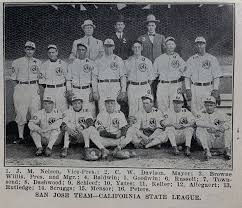Casey Stengel's Oakland Oaks
- David Hegler

- May 13
- 3 min read

All throughout World War II, soldiers who were on their way to the Pacific Theater became enamored with the states that rested on that side of America. They loved the warm weather and the seemingly endless opportunities that lay in store for the working class once the war ended. As a result, California's population boomed.
One of the industries that flourished as a direct result was baseball. While many minor leagues across America died due to an uncertain economy, the Pacific Coast League thrived once the war ended.
It was around this time that two theater-chain owners, Clarence "Brick" Laws and Joe Blumenfeld bought the Oakland Oaks and immediately began investing time and resources into its dilapidated stadium, Oaks Park. In a short while, the old ballpark had new lights and bleachers, a renovated clubhouse and a fresh coat of paint.
After watching their team tumble to fifth place in 1945, both Laws and Blumenfeld realized that 90-93 was merely respectable and did little to attract local attention. So they moved on from co-managers Dolph Camilli and Bill Raimondi and hired a little known manager who had yet to win a pennant named Casey Stengel.
Stengel stepped right into one of the best rivalries in all of baseball that first year, battling the powerful San Francisco Seals and their manager Lefty O'Doul for supremacy. Ultimately, the Oaks' impressive record of 111-72 was good enough for second place in the PCL, right behind their rivals from across the Bay.
But their season was far from over as the PCL had recently implemented a playoff system. After the Oaks beat the Los Angeles Angels 4-3, they lost the PCL title to the dreaded Seals 4-2 in the final. Despite the disappointing end, the Oaks had enjoyed one of their best seasons in quite a while.
Led by Rugger Adizoia's 105 strikeouts, the Oaks had allowed just 648 runs all year and Les Scarsella's team-leading 22 home runs helped draw some of the largest crowds in the PCL with 634,311 attending games at Oaks Park. Still, that number paled in comparison with San Francisco as the Seals drew a record 670,563, a standard that would stand for nearly 40 years.
The following year, the Oaks fell back to earth as they finished the year fourth in the league with a disappointing 96-90 record. Worse than that, they gave up 45 more runs than they scored all year while drawing just 590,327 fans to Oaks Park. Still, the team never stopped fighting. Four pitchers won 12 or more games, with Gene Bearden leading the way with 16 wins against just seven losses, a 2.86 ERA an 80 strikeouts.
That year, the team welcomed a tough-minded newcomer from nearby Berkeley named Billy Martin. Although he appeared in just 15 games and contributed just 12 hits, Stengel saw potential in his .226 batting average. He just knew that he could mold the youngster into an everyday sensation. Once the team's year ended once again in defeat, losing to the Seattle Rainiers 4-1 in the PCL final, Casey Stengel was more determined than ever before to finally win the pennant that had eluded him all of those years.
Once again, the road to the PCL title ran through those dreaded San Francisco Seals. Back and forth the two teams went as neither refused to give up the lead without a fight. Along the way, the Oaks boasted six pitchers who won 11 or more games while the team racked up win after win. Billy Martin even proved Casey Stengel to be prophetic as he found his groove at the plate, averaging .277 and posting a .689 OPS while driving in 42 runs. At regular season's end, the Oaks had won their division by two games, going 114-74.
Having vanquished their nemesis, the Oaks won the first round of the playoffs over the Angels 4-2 before enacting a measure of revenge against the Rainiers in the finals, winning their first PCL championship in 21 years 4-1. The city of Oakland threw a massive parade for Casey Stengel and his boys, gifting the manager a $5,000 car and the key to the city. With a fresh set of wheels and the key to the city in hand, Stengel left for New York after that memorable 1948 season, taking his young prodigy with him.

References



Comments